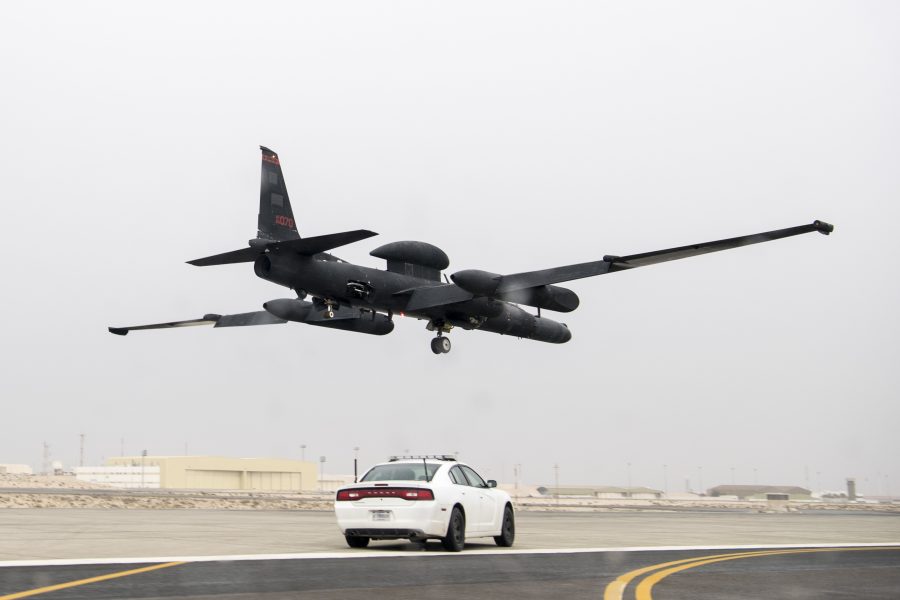U-2S is the Air Force’s only manned, strategic, high-altitude, longendurance ISR platform and is capable of SIGINT, IMINT, and MASINT collection. The aircraft’s modular payload systems allow it to carry a wide variety of advanced optical, multispectral, EO/IR, SAR, SIGINT, and other payloads simultaneously. Its open system architecture also permits rapid fielding of new sensors to counter emerging threats and requirements.
The original U-2A first flew on Aug. 4, 1955. The type was further developed into the larger, more capable U-2R which first took flight on Aug. 28, 1967, and was delivered between 1967 and 1968.  Current U-2s date to the 1980s when U-2R production was reopened under the designation TR-1 (later returned to U-2R designation in 1992). The TR-1A first flew on Aug. 1, 1981, and was reengined and modernized starting in 1994, emerging as the U-2S.
Current U-2s date to the 1980s when U-2R production was reopened under the designation TR-1 (later returned to U-2R designation in 1992). The TR-1A first flew on Aug. 1, 1981, and was reengined and modernized starting in 1994, emerging as the U-2S.
Current Block 20 U-2S features glass cockpits, digital autopilot, modernized EW system, and updated data links. Its major sensors are the ASARS-2A SAR, SYERS-2A multispectral EO/IR imagery system, and enhanced Airborne Signals Intelligence Payload (ASIP). The legacy optical bar camera is still used to provide broad-area synoptic imagery.
The fleet is currently undergoing Block 20.1 upgrades, adding ASARS-2B, next-generation SIGINT, avionics and navigation refresh, and data link (Link-16/ IFDL, MADL) modernization. ASARS-2B significantly improves the U-2’s high-altitude, deep-look radar ground mapping, moving target, and maritime capabilities.
ASARS-2B will begin flight-testing in FY22, and IOC is expected in FY23. U-2s are also receiving stellar and GPS-denied navigation, quick-change modular mission systems, multispectral sensor, and EW system upgrades. Airframe mods, helmet and pressure suit refresh, and egress improvement are also ongoing.
U-2s conducted several experiments in 2020, including using Artificial Intelligence to operate sensors and augment situational awareness, and using cloud computing to update mission software in-flight.
The program continues to prioritize experimental sensors, systems, and software to meet emerging threats and develop networked, next-generation BM/C2.
Contractors: Lockheed Martin, Northrop Grumman (ASIP); Raytheon (ASARS); UTC Aerospace (SYERS/Optical Bar Camera).
First Flight: October 1994 (U-2S).
Delivered: September 1981-October 1989 (TR-1/U-2R).
IOC: Circa 1981 (U-2R).
Production: 35 (T/U-2S).
Inventory: 27 (U-2); four (TU-2).
Operator: ACC.
Aircraft Location: Beale AFB, Calif.; permanent forward operating locations worldwide.
Active Variants: •U-2S. Current variant of the U-2/TR-1. •TU-2S. A two-seat trainer aircraft originally designated U-2ST.
Dimensions: Span 105 ft, length 63 ft, height 16 ft.
Weight: Max T-O 40,000 lb.
Power Plant: GE Aviation F118-GE-101A turbofan, 17,000 lb thrust.
Performance: Speed 410 mph, range 7,000+ miles.
Ceiling: Above 70,000 ft.
Accommodation: Pilot (U-2S); two pilots (TU-2S) on RQ201 zero/zero ejection seats.
